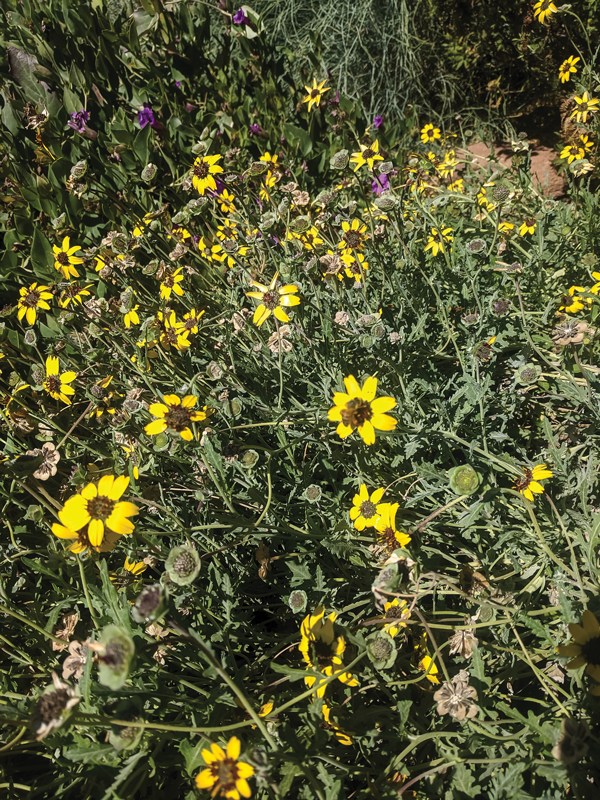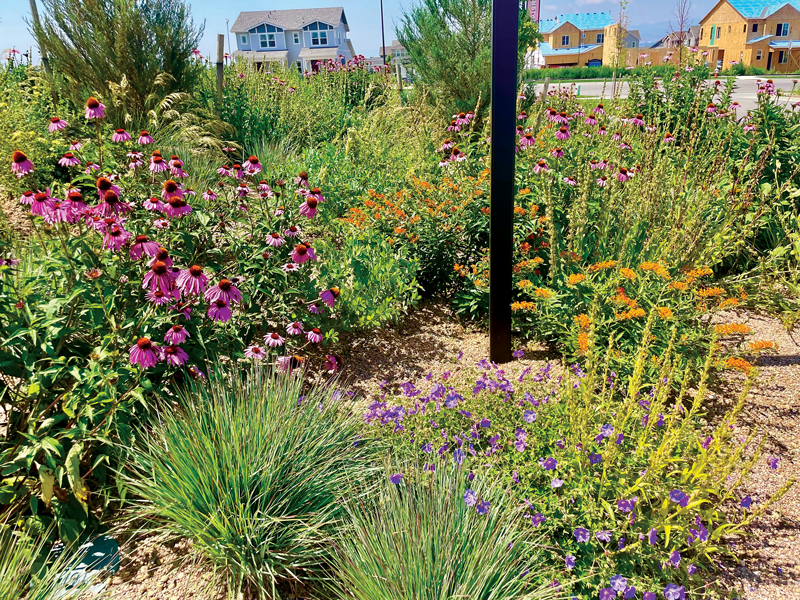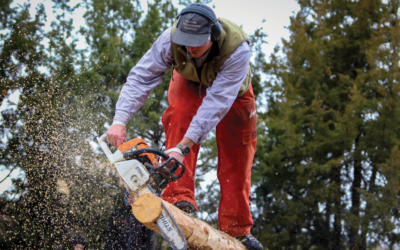Let’s face it: Green grass looks nice. Perfectly manicured lawns create a pleasant feeling as you walk your dog through the neighborhood. But they also demand lots of water in our dry and sunny climate, unnecessarily costing you and the environment.
And yet transforming your yard into a more sustainable space doesn’t have to mean sacrificing its beauty or functionality. With a few thoughtful choices, you can reduce your water bill, support local wildlife and create a vibrant, eco-friendly landscape.
Before diving into a full redesign, CSU Extension horticulturist Cassey Anderson suggests considering factors such as sun exposure, foot traffic and how much time you’re willing to invest in your yard’s upkeep. Once you’ve assessed the needs and limitations of your space—different plants require varying levels of sunlight, for example—it’s time to remove your existing turf.
“If you have a sprinkler system, I suggest working zone by zone rather than doing a whole landscape at once,” Anderson says. “It’s a little more cost-effective and lets you ease into the process.”
If you’re removing your turf entirely, Jim Tolstrup, executive director of the High Plains Environmental Center in Loveland, offers up three methods. The first involves using a sod cutter to remove the top layer of grass and soil. The second is applying herbicide to kill the turf. The third is smothering the grass with UV-resistant plastic. Tolstrup warns that the last method isn’t foolproof, as Kentucky bluegrass is notoriously resilient and often makes an unexpected comeback.
Then you can start redesigning your yard with your choice of lawn alternatives, from xeriscapes and hardscapes to pollinator gardens full of native plants.

Desert willow
Photo courtesy of CSU Extension.
Xeriscapes
Xeriscaping is a landscaping method that reduces water use by incorporating “xeric” plants, or species that have adapted to thrive in dry conditions. While many xeriscape gardens include plants native to Colorado, Tolstrup notes that xeriscapes can also feature low-water species from other arid regions. These drought-tolerant plants survive with minimal irrigation due to deep root systems, waxy or hairy leaves that help retain moisture or the ability to store water in their stems and foliage.
A successful xeriscape begins with careful planning, Tolstrup says, which means positioning the plants based on their sunlight requirements, the slope gradient of the land and their water needs to maximize their efficiency. Anderson recommends visiting the website for Plant Select, a local nonprofit that offers a multitude of free xeriscape plans and lists drought-tolerant plants.
For sunny spots, Plant Select suggests ice plants––the fire spinner and red mountain flame varieties are particularly stunning––penstemons, hyssops and various types of sage, all of which add beauty to hot, dry areas with minimal upkeep. For shadier spots, the organization recommends waxflower, yellow archangel, perennial foxglove and plumbago. And if you’re seeking groundcovers, they endorse desert moss, veronica varieties and “Turquoise Tails” blue sedum.
Anderson stresses that water savings won’t be immediate, as new plants require extra watering during their first season to establish strong root systems. Additionally, setting up a xeriscape can come at a sizable cost, though DIY projects can certainly lower your expenses if you do your research and consult free resources. Most xeriscaping plants are available at local garden centers, and Plant Select makes them easy to find with a sortable table to help you find the nearest retailer.
Zeroscapes and rockscapes
Though both of these landscaping methods center on the use of rocks and gravel, there is an important distinction between the two: The term “zeroscape” effectively means “zero plants,” while rockscapes may incorporate vegetation here and there.
When thoughtfully designed with features such as decorative boulders, pathways and hardy succulents, zeroscaped and rockscaped yards can create a modern, low-maintenance aesthetic. These landscape designs require little to no irrigation, making them ideal for homeowners looking to replace their grass with something that requires minimal water. They also eliminate the need for mowing, fertilizing and overall upkeep.
However, both Anderson and Tolstrup have reservations about these approaches due to their negative effect on beneficial insects and wildlife.
“Personally, I have little interest in these alternatives,” Tolstrup says. “They address the question of water use but do nothing to create habitat––i.e., forage and cover for wildlife. If a weed barrier is used in these installations, it creates a dead zone impenetrable to any organisms that live in the ground.”
Tolstrup points out that plants help to cool communities by reducing the “urban heat island effect,” a phenomenon in which urban areas become significantly hotter due to both heat-absorbing surfaces and a lack of vegetation. Zeroscaping and rockscaping contribute to this effect because they feature the same heat-retaining materials, like gravel and stone, while lacking the cooling benefits of plants.
This doesn’t mean you have to stay away from rocks altogether. Rather, it’s all about how you use them.
“There can be situations in which rock as a mulch can be beneficial for xeric plants,” Anderson says. “But that’s different from a rockscape with large ornamental rocks and boulders. Those don’t have a whole ton of benefits.”

Chocolate flower
Photo courtesy of CSU Extension.
Native pollinator gardens
It’s not necessary to exclusively plant native species in your yard—“bringing in a broader palette of plants that work well for our landscape increases our ability to have diversity,” Anderson says—but it’s true that native plants play a crucial role in supporting our ecosystem and local wildlife.
Alison O’Connor, a horticulturist for Larimer County and the CSU Extension, recommends several native species.
“Some native perennials that do well in most landscapes include sulphur flower, chocolate flower (which smells like Hershey’s chocolate), penstemon, little bluestem and blanketflower,” she says. “Some good shrubs include leadplant, Apache plume, rabbit brush, mountain mahogany and skunkbush sumac––this one also has a nice fall color.”
O’Connor advises gardeners to have realistic expectations when choosing natives, as many don’t thrive in containers and may look sparse at nurseries. But once they’re planted in Colorado soil, these plants thrive. They need regular watering during the first growing season and should be placed in a sunny spot where they have room to grow naturally. O’Connor recommends skipping soil amendments, as native plants are adapted to Colorado’s natural soils. When planting shrubs, she stresses the importance of giving them space to reach their full size with minimal pruning.
For those hoping to attract pollinators, Tolstrup recommends a diverse selection of plants that bloom at different times throughout the year.
“To support wildlife in your gardens, you want to have things that bloom in the early spring, late spring, early summer, late summer, early fall and late fall,” he says. “I always tell people, ‘I don’t eat just on Mondays. I don’t eat just in April. I eat every day, multiple times a day. It’s the same thing with wildlife. You have to have things in your garden growing all year in order to support it.”
Aside from incorporating native plants, there are a couple key ways to make your yard more pollinator-friendly, Tolstrup says. First, grouping plants together helps to provide the shelter and nesting spaces pollinators need. Second, installing shallow birdbaths offers an easy water source––something they’ll undoubtedly appreciate during the hottest days of the year.
“If we’re providing habitat for our small and medium wildlife, including bees and butterflies, then we can have a more diverse space to live in,” Anderson says. “Green spaces help all of us feel better and be healthier, so it’s a great thing to aim toward if you have the time and the resources.”
_______________________________________________________________________________
Xeriscapes and HOAs
In 2019, Colorado passed HB19-1050, preventing HOAs from banning xeriscaping.
In 2023, Governor Polis signed SB23-178, the Water-wise Landscaping in Homeowners’ Association Communities bill, allowing homeowners to use at least 80 percent drought-tolerant plants in their yards.
_______________________________________________________________________________
Lush Lawns That Use Less Water
Not ready to say goodbye to your lawn just yet? These drought-tolerant grasses keep your yard green while conserving Colorado’s most precious resource.
Buffalograss – A top recommendation for a drought-friendly lawn is buffalograss, a hardy, warm-season grass native to Colorado. While it doesn’t withstand heavy foot traffic as well as Kentucky bluegrass, it thrives in full sun and requires minimal watering, making it one of the most heat- and drought-tolerant options available.
Whereas Kentucky bluegrass begins greening up as early as March, buffalograss remains dormant until early May. It also doesn’t tolerate frequent mowing, so it will naturally take on a longer, more organic look.
Blue grama – Another option praised by Anderson and Tolstrup is blue grama, the state grass of both Colorado and New Mexico. Like buffalograss, blue grama is a warm-season grass that has evolved to withstand the state’s arid conditions, making it an ideal option for droughts and heat waves.
Like buffalograss, blue grama cannot withstand frequent mowing. So while it will never resemble a golf course, when given the proper care and plenty of Colorado sunshine, it will still look remarkably green, thick and lush.
Tahoma 31 – If you prefer a golf course look, Tahoma 31 could be the option for you. Although the grass isn’t native to Colorado, Anderson assures it comes with a variety of benefits.
“Tahoma 31 is a type of Bermuda grass that is more hardy and tolerant of cold than most types of Bermuda grass,” she says. “It’s also a sterile hybrid, so it’s never going to seed and will only spread through its root system. It is twice as expensive as a bluegrass sod, but once it’s established, it will use about 60 percent less water.”
Dog Tuff grass – For homeowners seeking a traditional-looking lawn, Dog Tuff grass—a resilient Bermuda variety—thrives in hot, dry conditions and is especially pet-friendly due to its durability.
“In peak summer heat, Dog Tuff stays bright green with minimal water,” Tolstrup says. “While Kentucky bluegrass greens up early, it often looks scorched by August—right when Dog Tuff is at its best. It’s called Dog Tuff because you don’t get the brown spots from dog pee, and it’s so thick and tough that dogs can’t kill it, even if the dogs run back and forth along the fence all day.”







